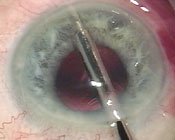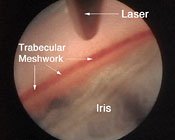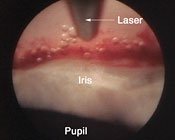Trabecular meshwork ablation shows promise as alternative to invasive glaucoma surgery
Combined phaco-ELT patients needed fewer reinterventions over 3 years follow-up than phaco-trabeculectomy patients, despite similar IOPs.
 Excimer laser trabeculotomy (ELT) laser fiber and endoscope inserted into the anterior chamber through a corneal incision. The probe is 1.5 mm in diameter. Images: Funk J |
NUREMBERG — A procedure that uses an excimer laser probe to create a series of holes in the trabecular meshwork appears to be an effective, less invasive surgery for reducing IOP, according to a surgeon speaking here.
According to Jens Funk, MD, PhD, excimer laser trabeculotomy ab interno (ELT) is a minimally invasive procedure that uses an excimer laser to ablate pores in the trabecular meshwork of patients with open-angle glaucoma. Because the procedure uses photoablation, no thermal effect is generated, he said; this helps prevent thermal necrosis and scar formation, potentially allowing a persistent effect over several years.
Additionally, the procedure is performed transcorneally, which allows it to be done alone or in combination with phacoemulsification without damaging the conjunctiva or sclera, he said.
Prof. Funk presented his experience performing ELT at the German Ophthalmic Surgeons annual meeting.
“We do not have alteration of the conjunctiva, which is a great advantage over other combined cataract-glaucoma surgeries. That is to say, we have trabeculotomy and deep sclerectomy, all of which lead to conjunctival scarring and, of course, related problems,” he said.
Prof. Funk said he uses the Aida excimer laser (TuiLaser AG), which is CE certified and commercially available in Europe.
Surgical procedure
In performing ELT, a 1.5-mm-diameter laser probe is inserted into the anterior chamber through a transcorneal incision and positioned adjacent to the anterior chamber angle, Prof. Funk said.
The 308-nm excimer laser fiber is advanced up to the trabecular meshwork. A series of 20 laser pulses is then applied to create 10 pores, which allow aqueous to visibly percolate, he said.
As a rule, 10 pores are made around the angle, but there is no set specification as to where the pores are created. The whole procedure takes less than 2 minutes to perform, he said, noting that histologic examination and electron microscopy have confirmed the effects.
“In histologic study, two things have impressed me; you do not get thermal necrosis and you do not affect the posterior wall of Schlemm’s canal. These two prospects are important, and we can be hopeful that these new pores will not soon scar,” he said.
Dr. Funk noted that it is normal for there to be slight bleeding from the pores at the end of the procedure, which indicates the meshwork has been successfully perforated. The blood also absorbs laser energy, protecting deeper strata from injury, he said. The bleeding should immediately stop when pressure is restored to the eye, he said. He noted that small bubbles also form during the procedure, but it is not known whether they are from cavitation or air.
Most effective with phaco
According to Prof. Funk, ELT more effectively lowers IOP when combined with phacoemulsification. Data collected from six sites in Germany showed ELT combined with phacoemulsification caused an average 38.8% reduction in IOP from a preoperative mean of 26.8 mm Hg to a mean of 16.4 mm Hg at 6 months postoperatively. Prof. Funk, who conducted the study with Sonja Wilmsmeyer, MD, noted that there was also a decline in mean medication use from 1.3 preop to 0.3 at 6 months postop.
Results for 50 patients treated with combined ELT-phaco at Prof. Funk’s facility in Freiburg, Germany, showed patients had an average reduction in mean IOP of 28.9% from 22.5 mm Hg preop to 16 mm Hg at 6 months postop, he said.
“What is interesting is that all of us who use this method almost always end up with 16 mm Hg postoperatively. We cannot lower it much more than that. We cannot get below the episcleral venous pressure,” he said.
Prof. Funk noted ELT is effective as monotherapy, but does not lower IOP as significantly as the combined procedure.
According to the presentation, among 69 patients treated only with ELT at the Freiburg center, mean IOP decreased from 24.1 mm Hg to 20 mm Hg at 6 months. Mean medication use also decreased from 1.9 medications preop to 1.3 at 6 months. Prof. Funk noted that he has some patients who have been followed 2 years or more who have not experienced a deterioration in IOP control, suggesting the effect persists over the long term.
ELT vs. trabeculectomy
Prof. Funk also compared combined ELT-phaco to ELT combined with trabeculectomy. In the study, both groups experienced similar decreases in IOP — 33.7% for ELT-phaco patients and 33.3% for trabeculectomy-phaco patients, he said. But patients in the ELT-phaco group required fewer reinterventions over 3 years follow-up – 6% vs. 53% for trabeculectomy-phaco patients.
Prof. Funk noted that ELT does not affect the conjunctiva, allowing patients to undergo trabeculectomy at a later time if the original intervention fails.
|
For Your Information:
- Jens Funk, MD, PhD, can be reached at Univ.-Augenklinik, Killianstr. 5, 79106 Freiburg, Germany; 49-761-270-4001; fax: 49-761-270-4174; e-mail: funk@aug.ukl.uni-freiburg.de.
- TuiLaser AG, makers of the Aida excimer laser, can be reached at Industriestrasse 15, 82110 Germering, Munich, Germany; 49-89-89407-0; fax: 49-89-8545610; e-mail: info@tuilaser.com; Web site: www.tuilaser.com.
- Michael Piechocki is an OSN Staff Writer who covers all aspects of ophthalmology, specializing in oculoplastics. He focuses geographically on Europe and the Asia-Pacific region.


